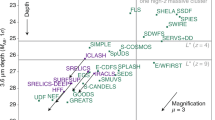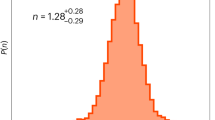Abstract
THE observation of close pairs of QSOs with very different redshifts has been suggested to be evidence in support of the noncosmological redshift hypothesis1,2. The statistical arguments used by Stockton1 and by Wampler et al.2 have recently been attacked by Bahcall and Woltjer3 on the ground that the method used is one of a posteriori statistics. Statistics aside, they have ignored the point that in one case2, the evidence is not only based on close proximity of the two QSOs but also on two coincidences in wavelengths in the spectra of the two objects. Although the argument against a posteriori statistics is correct in the absolute sense, this method is widely used in astronomy and has generally been accepted, except in cases in which the hypothesis under consideration has not reached the point of general acceptability. The redshift controversy is a good example of this. Evidence as to the existence of non-cosmological redshifts must, because we have few ways of measuring distance, depend upon finding conflicts between distances derived from the redshifts (assumed cosmological) and distances derived in other ways4—either through statistical arguments or by finding luminous connections between pairs of objects. If, as seems to be the case, most workers use the redshift as the prime criterion of distance, and subordinate other methods of measurement to it, no solution to the problem is possible.
This is a preview of subscription content, access via your institution
Access options
Subscribe to this journal
Receive 51 print issues and online access
$199.00 per year
only $3.90 per issue
Buy this article
- Purchase on Springer Link
- Instant access to full article PDF
Prices may be subject to local taxes which are calculated during checkout
Similar content being viewed by others
References
Stockton, A. N., Nature phys. Sci., 238, 37 (1972).
Wampler, E. J., Baldwin, J. A., Burke, W. L., Robinson, L. B., and Hazard, C., Nature, 246, 203 (1973).
Bahcall, J. N., and Woltjer, L., Nature, 247, 22 (1974).
Burbidge, G. R., Nature phys. Sci., 246, 17 (1973).
Burbidge, G. R., and O'Dell, S. L., Astrophys. J. Lett., 182, L47 (1973).
Gunn, J. E., Astrophys. J. Lett., 164, L113 (1971).
Wolf, R. A., and Bahcall, J. N., Astrophys. J., 176, 577 (1972).
Author information
Authors and Affiliations
Rights and permissions
About this article
Cite this article
BURBIDGE, E., BURBIDGE, G. & O'DELL, S. Physical Sciences: Statistical analysis of close pairs of QSOs. Nature 248, 568–569 (1974). https://doi.org/10.1038/248568a0
Received:
Issue Date:
DOI: https://doi.org/10.1038/248568a0
This article is cited by
-
The statistics of quasar pairs
Nature (1986)
-
The statistics of quasar pairs
Nature (1986)
-
Q1146+111B,C quasar pair: illusion or delusion?
Nature (1986)
-
The statistical significance of close pairs of QSOs
Nature (1985)
-
Quasars and the cosmological distance scale
Nature (1976)
Comments
By submitting a comment you agree to abide by our Terms and Community Guidelines. If you find something abusive or that does not comply with our terms or guidelines please flag it as inappropriate.



